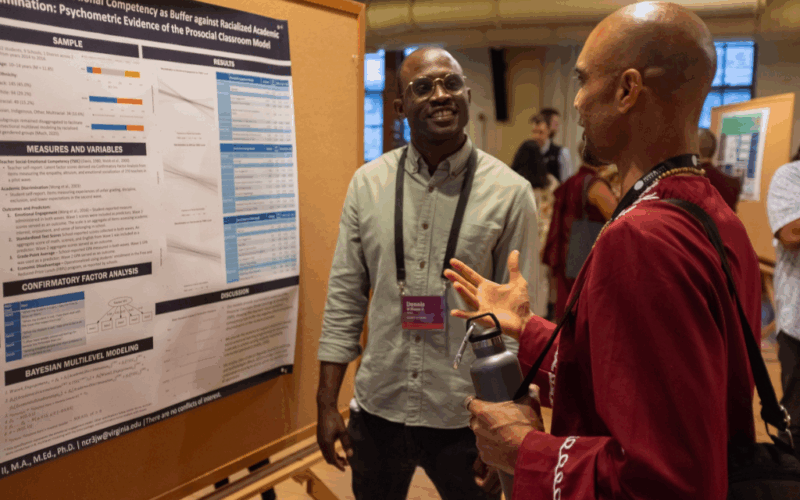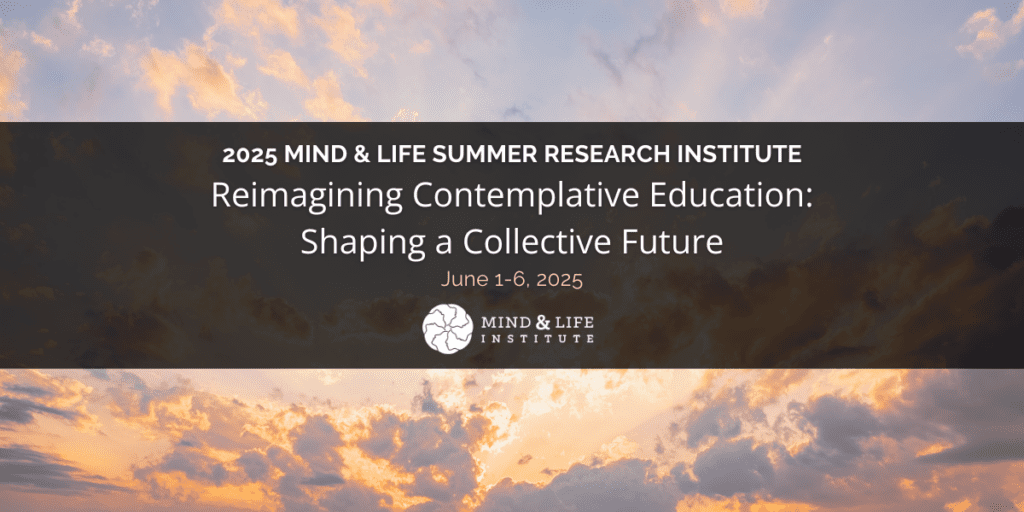
Mind & Life periodically invites guest writers to contribute to the blog as a way of deepening dialogue and understanding around key themes related to our mission. In this post, a participant at our 2025 Summer Research Institute reflects on her experience.
I have performance anxiety. I thrive in groups of two—me and one other person—when I can connect deeply with that other person. The moment there are more than one pair of eyes on me, my ability to connect with myself and deeply with the other becomes limited. I say this because it colors my experiences and sometimes I don’t realize what’s happening until days or weeks after it has passed.
This is the backdrop to my experience at Mind & Life’s 2025 Summer Research Institute (SRI), where more than 120 people from 18 countries—educators, scientists, scholars, contemplatives, artists, policy makers, and students—came together to engage around the theme of Reimagining Contemplative Education: Shaping a Collective Future. The meeting took place from June 1-6 at the Garrison Institute, a former monastery perched above the Hudson River in New York.
I had written another version of this blog post (actually several versions), but came to realize that I hadn’t been feeling my emotions, and felt it was important to be forthcoming about my experience of anxiety. As those who come to contemplative practice with anxiety know, it’s a matter of exercising awareness and remembering to apply those tools. Feel it to heal it, takes practice.
“As those who come to contemplative practice with anxiety know, it’s a
matter of exercising awareness and remembering to apply those tools.”
The truth is academic conferences frighten me. I feel like I have to know things and be things, especially with a terminal degree under my belt. I also feel like I have to know where I’m going, which I don’t. What I do know is what I’m doing right now, which is studying the effects of contemplative practice on young people’s social and emotional well-being. And it’s very much connected to how I arrived at this work.
I grew up in a community that valued and promoted contemplative practice; yet being in an environment where enlightenment was the most important thing in life didn’t make things easier. As a highly anxious teen with no sense of ease in my body, I used the only tools I knew: self-imposed pressure and sheer force. This was compounded by the absence of any self-regulatory skills throughout my childhood and much of my adult life. Thankfully, I’ve learned how to feel more at ease in my body.
What this means is my true experience at SRI was a bit different from the one I thought I had. Arriving at SRI, I was excited, open to experience everything because the last time I was there in 2012, I couldn’t fully immerse myself due to other obligations. This year, I was still a bit anxious with the academic component and all the people there.
So I return to this year’s SRI theme: “Reimagining Contemplative Education,” wondering how this connects to my own experience and the needs of the world beyond? In the US alone, one in three adolescents will experience anxiety disorder, a proportion that’s been growing in response to pressures to succeed, growing threats in our world from violence to climate change, and the influence of social media. While my interest in contemplative education was personal, it also echoed a strong desire among SRI participants to equip students with the tools to navigate a rapidly changing world and shape our collective future for the better.
Returning to the body emerged as a key theme for me. Author and Buddhist-Quaker Dharma teacher Valerie Brown reminded us that returning to the breath is one of the ways we can begin to create a future for us all. As we start to connect and feel safe and present in our bodies, we can show up more fully, and more wisely, for others. This is also one of the key pathways to breaking down the mental health issues proliferating in today’s world, of which anxiety makes up a disproportionate share. As educator and activist Parker Palmer once said, “Community cannot take root in a divided life… Only as we are in communion with ourselves, can we find community with others.”
“Returning to the body emerged as a key theme for me.”
Movement is also (my) medicine, and one of the fastest ways for me to reconnect with my body. I drank in the yoga and qi gong sessions led by educator and yogi Hawah Kasat. I meandered through the labyrinth just beyond the walls of the Garrison property. I danced in the cool refuge of the basement. And I wandered through the forest—in twos and threes—but mostly, it was just me and the trees. And I enjoyed it most on the day of silence. While others were inside contemplating, I was outside having a joyous conversation with nature—learning to trust where it beckoned. It was expansive and free. And when I made it past a stretch where the path gave way to wilderness, it felt revelatory. Despite fallen branches rendering the path unclear to pursue, my inner guidance nudged me forward. The revelation to trust my inner knowing even if a way forward is not clear was strengthened even further.
I love nature. This is one of the reasons I felt so drawn to the sessions on contemplative ecological education. Having spent over a decade in southwest Canada, it didn’t take long to realize why their license plates proclaim “Beautiful British Columbia.” I came to appreciate the beauty of nature and what it does for the soul. It’s medicine that helps the mind quiet, the body calm, and insights to arise. As environmental neuroscientist Pooja Sahni shared, the benefits of being in nature, a state of “relaxed alertness,” are similar to the benefits of contemplative practice. Nature is also an ideal setting for anxious individuals who naturally incline toward excess interoception. Having calming visual and auditory input outside the body can ease the tendency to overfocus on and inside the body.
Beyond these somatic and emotional effects, there is also so much we can learn from the Earth itself. Core to much of Indigenous and traditional wisdom is the deep relationship with the land, and learning from it helps us see the cycles of life, the ebbs and flows, the natural seasons. These are wisdoms that Indigenous children’s book writer Monique Gray Smith shared with us. But we know that nature is under threat, and climate change is mostly human induced. The Indigenous and traditional wisdoms of interdependence and interconnectedness, and the frameworks on systems thinking presented by Buddhist scholar and contemplative educator Brendan Ozawa-de-Silva can be helpful here, not just for understanding what is happening, but to protect nature and prevent further damage and degradation. Contemplative practice also serves a vital role. As I’ve learned, the more I practice, the more my thoughts, emotions, and beliefs are connected to the experiences I draw in. It is an embodied experience of interconnectedness with all.
This embodiment is what led to many chance meetings with new friends, often over and over again, at SRI. It also led to an illuminating hallway conversation about cultural differences, not just of language, but of cultural values in research. “Toolkits, not toothbrushes!” as proposed by the panel on measurement, referring to the tendency for scientists to treat measures like toothbrushes (not to be shared), and to instead, create a toolkit of measures (to be shared) to help move the field forward. The idea was indeed aspirational and one I got excited about. But later, I realized it could only be viable in contexts with people who hold the same cultural values. I walked away with a deeper sense of cultural humility and a greater understanding of the openness needed to forge a future together.
This sense of humility can be extended to all facets of community. Just as ecology thrives in biodiversity, community flourishes when all views are embraced, including discomforting and contradictory truths. As author and contemplative leader Meena Srinivasan reminded us, practice is the ability to hold paradox, whether it is stillness and action, faith and science, or right and left. All have a place in the same room. It is all part of the human experience.
As SRI came to a close, I walked in late to the final session, with three others in the same boat. It was perfect; we formed our own group. What a beautiful way to reconnect with each other and the past week in this experience. And in the final round, the song that was played for me took me back home to the teachings of my own tradition of Dhammakaya—magically, it was full circle:
Please let me feel inner peace, from my center, at the center of me…My heart is open, I am aware, in me’s a knowing of love, love, love…
M. Jennifer Kitil is a Postdoctoral Research Associate at the Social and Emotional Learning lab at the University of Illinois Chicago. She currently lives in Thailand with her mother.
Photo credits: Phil Walker and Jacob Gordon.




